Youth football drills are essential for developing fundamental skills, teamwork, and strategy in young players. They combine physical training with fun, fostering growth and sportsmanship.
1.1 Importance of Drills in Youth Football Development
Drills are vital for youth football development, fostering fundamental skills, teamwork, and strategic thinking. They provide structured repetition, helping players master techniques like ball control, passing, and tackling. Drills also enhance agility, speed, and coordination, while building mental toughness and discipline. By focusing on specific aspects of the game, drills ensure comprehensive development, preparing young athletes for competitive play. They also promote engagement, keeping players motivated and eager to improve. Effective drills are age-appropriate, ensuring safety and suitability for varying skill levels. Ultimately, they lay the groundwork for future success in football, both on and off the field.
1.2 Brief Overview of Key Skills Taught Through Drills
Drills in youth football focus on building essential skills such as ball control, dribbling, passing accuracy, and receiving techniques. They also emphasize defensive skills like tackling and blocking, ensuring a well-rounded development. Agility and speed are enhanced through specific exercises, improving overall athleticism. Drills additionally teach teamwork, strategy, and decision-making, crucial for game situations. By incorporating these elements, drills prepare young players for the demands of competitive football. Each skill is introduced progressively, allowing players to build confidence and competence. The structured nature of drills ensures that players develop both physical and mental capabilities, creating a strong foundation for their football journey.
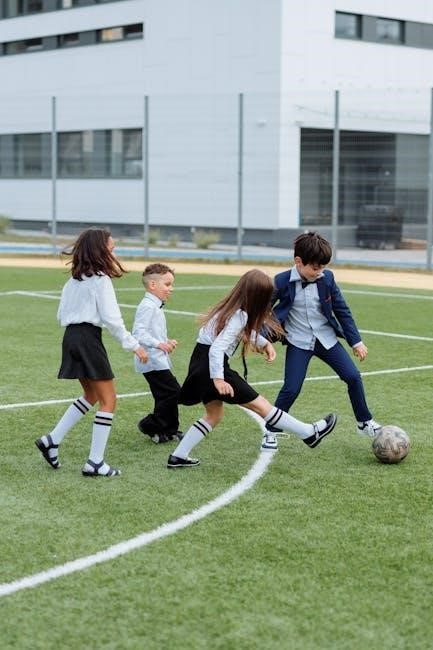
Foundational Skills for Youth Football
Youth football drills focus on developing essential skills like ball control, passing accuracy, and receiving. They also enhance agility, speed, and teamwork, preparing players for competitive play effectively.
2.1 Ball Control and Dribbling Drills
Ball control and dribbling drills are fundamental for youth football, teaching players to maintain possession and maneuver the ball effectively; These exercises often involve cones or small obstacles to simulate game-like scenarios. Players practice tapping, cutting, and changing direction with the ball at their feet. Drills such as the “Figure-8” and “Zig-Zag” challenge coordination and precision. Emphasizing proper foot placement and head-up awareness helps players control the ball while scanning the field. These skills are crucial for creating scoring opportunities and maintaining possession during matches, making them a priority in youth football development programs.
2.2 Passing Accuracy and Technique
Passing accuracy and technique are vital skills in youth football, enabling players to deliver precise and effective passes during gameplay. Drills such as the “Chest Pass Drill” and “Partner Passing” help players master short and long passes. Emphasizing proper foot placement, body positioning, and follow-through ensures consistency. Players practice passing with both hands and while moving, improving their ability to adapt to game situations. These exercises build confidence and teamwork, as accurate passing is essential for maintaining possession and creating scoring opportunities. Coaches often incorporate hydration and nutrition tips to keep players energized during these focused training sessions;
2.3 Receiving and Catching Skills
Receiving and catching skills are crucial for youth football players to secure passes and maintain possession. Drills like the “Chest Pass Drill” and “Partner Passing” help players master catching techniques. Young athletes practice catching with both hands, focusing on proper hand positioning and body alignment. Advanced drills incorporate movement, such as catching while running or changing direction. Coaches emphasize keeping eyes on the ball and securing it tightly. These exercises improve hand-eye coordination and confidence. Incorporating game-like scenarios ensures players can apply these skills effectively during matches. Proper hydration and nutrition are also highlighted to keep players energized throughout these focused training sessions.
2.4 Agility and Speed Training
Agility and speed training are vital for youth football players to enhance quick movements and explosive acceleration on the field. Drills like ladder drills, cone weaves, and shuttle runs improve footwork and agility. Speed training incorporates sprints, hill climbs, and resisted runs to build raw speed and power; These exercises are designed to be engaging while challenging athletes to push their limits. Proper warm-up routines are essential to prevent injuries during these high-intensity sessions. Coaches often use cones, flags, and other tools to create dynamic and effective drills. The focus is on improving reaction time, balance, and overall athleticism, which are critical for success in football.
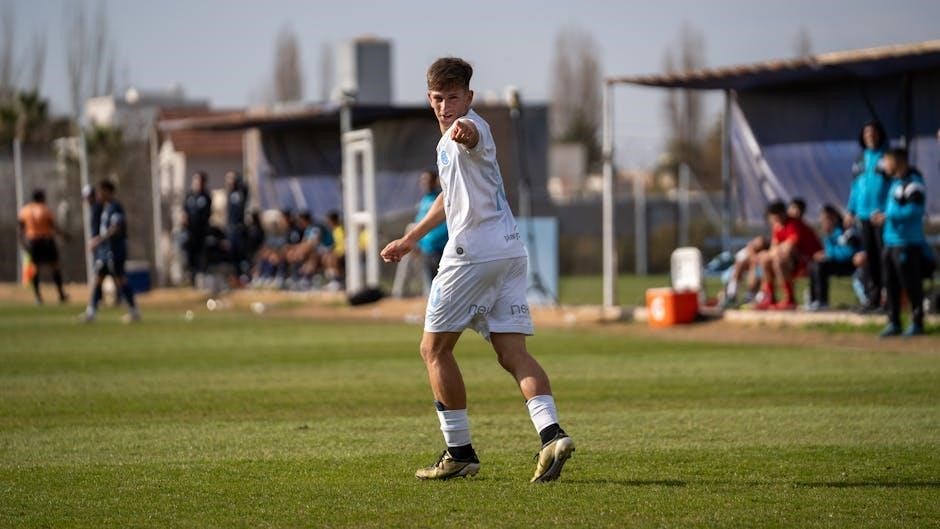
Specific Youth Football Drills
These drills focus on developing offensive and defensive skills through targeted exercises like the Angle Tackle Drill and Cross Drill, emphasizing teamwork and strategic play.
3.1 Angle Tackle Drill for Defensive Skills
The Angle Tackle Drill enhances defensive players’ ability to approach ball carriers at various angles, improving tackling technique and reducing injury risks. Players practice proper form, ensuring safety and effectiveness.
3.2 Cross Drill for Receiver Training
The Cross Drill is a passing exercise designed to improve receivers’ ability to catch passes at various angles and enhance their timing with the quarterback. Players line up in two groups on opposite sides of the field, with each group having a quarterback. Receivers run crossing routes, creating opportunities for catches from both sides. This drill helps develop hand-eye coordination, reaction time, and the ability to adjust to different throwing angles. It also builds teamwork and communication between receivers and quarterbacks, preparing them for game situations. The Cross Drill is an effective way to simulate real-game scenarios and improve overall receiving skills in a dynamic and engaging manner.
3.3 Bag & Board Drill for Blocking Technique
The Bag & Board Drill is a fundamental exercise for teaching proper blocking techniques, particularly for double-wing blocking. This drill uses a blocking bag and a board to simulate defensive players, allowing linemen and blockers to practice their footwork, hand placement, and driving technique. Players approach the bag, explode into contact, and drive the bag forward, maintaining control throughout. This drill emphasizes the importance of staying low, using leg strength, and maintaining balance. It is an effective way to develop blocking skills in a controlled and repetitive manner, helping players build confidence and proficiency in their technique. The Bag & Board Drill is a cornerstone of youth football training.
3.4 World Cup Game for Teamwork and Strategy
The World Cup Game is a dynamic and engaging drill designed to foster teamwork and strategic thinking among young football players. It involves dividing players into teams and organizing small-sided matches with specific objectives. This drill encourages communication, coordination, and decision-making under game-like conditions. Players learn to work together, execute plays, and adapt to different scenarios, enhancing their ability to think critically on the field. The competitive nature of the game keeps players motivated and focused, making it an effective tool for building camaraderie and tactical awareness. The World Cup Game is a fun and impactful way to develop essential teamwork and strategy skills in youth football.
Equipment Needed for Drills
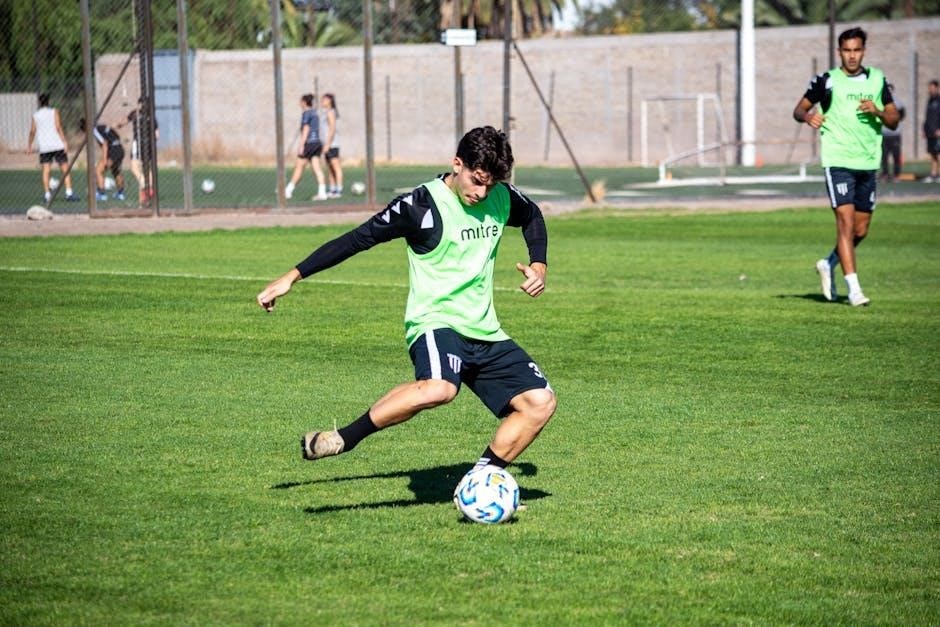
Essential equipment includes full pads, helmets, cones, flags, tackling bags, and blocking boards. These tools ensure safety and help players master fundamental skills effectively during drills.
4.1 Essential Gear for Full-Pad Drills
Full-pad drills require proper protective equipment to ensure player safety. Essential gear includes helmets, shoulder pads, mouthguards, thigh and knee pads, and football cleats. These drills focus on tackling, blocking, and contact skills, making safety a priority. Coaches emphasize the importance of wearing all gear correctly to prevent injuries. The equipment allows players to practice advanced techniques confidently while developing strength and agility. Properly fitted gear ensures optimal performance and protection during intense training sessions. These drills help young athletes build fundamental football skills in a secure environment, promoting both physical and mental growth. Safety remains the top priority, guiding the selection of all equipment used.
4.2 Use of Cones, Flags, and Other Training Tools
Cones, flags, and other training tools are vital for structuring effective youth football drills; Cones are used to set up agility courses, helping players improve speed and coordination. Flags mark boundaries or targets, enhancing spatial awareness and strategy. These tools allow coaches to create organized, dynamic drills that keep players engaged. For example, cone drills focus on quick changes of direction, while flags help in setting up passing or receiving zones. Other tools, like tackling bags, aid in teaching proper blocking and tackling techniques. The versatility of these tools ensures drills are tailored to skill levels, making training sessions productive and fun for young athletes.
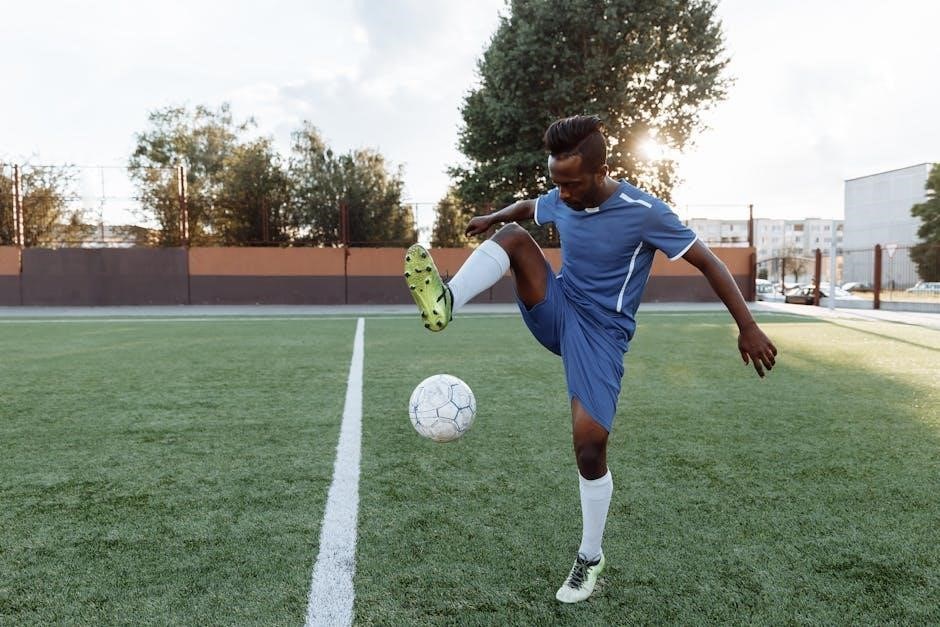
Age-Specific Drills
Drills are tailored to age groups, focusing on fun and basics for younger players, intermediate skills for preteens, and advanced techniques for older youth, ensuring progression.
5.1 Drills for Ages 6-8: Focus on Fun and Basics
For children aged 6-8, drills should prioritize fun and fundamental skill development. Activities like the World Cup game and simple passing exercises engage young players while teaching teamwork and basic techniques. These drills use minimal equipment, focusing on movement, coordination, and ball control. Games are designed to keep kids excited and active, ensuring they build a love for the sport. Emphasizing participation over competition, these drills help young athletes develop essential skills in a supportive environment. The goal is to create a positive introduction to football, fostering confidence and a strong foundation for future growth.
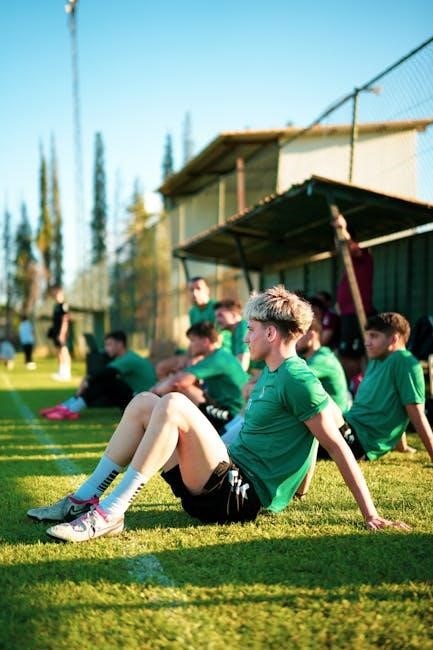
5.2 Drills for Ages 9-11: Building Intermediate Skills
Drills for ages 9-11 focus on refining intermediate skills, combining fun with structured learning. Activities like the Angle Tackle Drill and Cross Drill enhance tackling and receiving techniques. These exercises improve agility, speed, and teamwork while maintaining engagement. Coaches use cones and flags to create challenging yet manageable tasks, ensuring players build on their foundational skills. The emphasis is on developing game-like scenarios to prepare young athletes for more competitive play. Through these drills, players strengthen their abilities in a dynamic and motivating environment, setting the stage for advanced training as they grow.
5.3 Drills for Ages 12-14: Advanced Techniques
For ages 12-14, drills focus on refining advanced techniques, preparing players for competitive football. Exercises like the Angle Tackle Drill and Cross Drill are adapted to enhance defensive and offensive skills. Players learn complex strategies, such as double-wing blocking and advanced receiving routes. Drills incorporate full pads and equipment like tackling bags to simulate game scenarios. Emphasis is placed on improving speed, agility, and decision-making. These drills also introduce leadership and teamwork concepts, fostering mental toughness. Coaches ensure a balance between skill development and safety, preparing athletes for higher-level competition while maintaining engagement and motivation.
Incorporating Games into Drills
Incorporating games into drills makes training dynamic and engaging. Games like the World Cup Drill and Flag Football teach teamwork, strategy, and skills in a fun, competitive environment.
6.1 Using Small-Sided Games for Skill Development
Small-sided games are a powerful tool for youth football development, fostering skill mastery and teamwork in a dynamic, engaging environment. Games like 3v3 or 4v4 simplify the game, allowing players to focus on ball control, passing, and decision-making. These games encourage creativity and problem-solving while maintaining high levels of physical activity. By reducing the number of players, each participant receives more touches on the ball, enhancing technical skills. Coaches can adapt these games to focus on specific skills, such as dribbling or defensive positioning, making them versatile for various developmental stages. Small-sided games also promote tactical awareness and spatial understanding, preparing young athletes for larger, more complex matches.
6.2 Flag Football Drills for Simplified Play
Flag football drills simplify the game, focusing on speed, agility, and skill development without full-contact tackling. These drills emphasize ball control, passing accuracy, and teamwork, making them ideal for younger players. By removing complex strategies, flag football allows youth athletes to concentrate on fundamental movements and decision-making; Drills like red zone rushes and end zone tag promote quick thinking and spatial awareness. They also encourage players to practice evasive maneuvers and strategic positioning. Flag football drills are versatile, adapting to various skill levels, and provide a fun, engaging way to improve overall football proficiency while maintaining player safety and enjoyment. They are a cornerstone of youth football development programs.

Tackling and Blocking Drills
Tackling and blocking drills teach safe techniques, essential gear use, and game situational strategies, focusing on proper form and player safety while enhancing defensive and offensive skills.
7.1 Safe Tackling Techniques for Youth Players
Safe tackling techniques are crucial for minimizing injuries in youth football. Coaches emphasize proper head positioning, shoulder use, and body alignment to ensure players tackle effectively without endangering themselves or others. Drills like the Angle Tackle Drill focus on controlled, precise movements, teaching athletes to wrap up opponents securely; Emphasizing proper equipment fitting and supervised practice helps reinforce these skills. Hydration and warm-ups are also stressed to prevent fatigue-related mistakes. By mastering these techniques, young players build confidence and reduce injury risks, fostering a safer, more enjoyable game environment.
7.2 Double-Wing Blocking Drill
The Double-Wing Blocking Drill focuses on teaching linemen and blockers proper technique for engaging defenders. Players pair up, with one acting as the blocker and the other as the defender. Using blocking bags or boards, the drill emphasizes exploding off the line, maintaining a low stance, and driving through the block. Coaches highlight the importance of hand placement, footwork, and balance to ensure effective and safe execution. This drill is crucial for building strength, coordination, and teamwork, preparing players for game scenarios where precise blocking is essential for advancing the ball and protecting the quarterback.
Mental and Physical Preparation
Mental and physical preparation are vital for youth football. Proper warm-ups, hydration, and nutrition fuel performance, while focus exercises enhance mental toughness and readiness.
8.1 Warm-Up Routines for Injury Prevention
A proper warm-up is essential for youth football players to prepare physically and mentally. It increases heart rate, raises body temperature, and enhances muscle flexibility, reducing injury risks. Dynamic stretches, light cardio, and mobility exercises are key components. Players should focus on movements that mimic game actions, such as high knees, lunges, and leg swings. Additionally, incorporating ball drills during warm-ups engages players and sharpens their skills. Coaches should ensure all participants follow a structured routine tailored to their age and skill level, creating a safe and effective transition into practice or gameplay.
8.2 Cool-Down and Recovery Techniques
A cool-down after practice or a game is crucial for youth football players to gradually lower their heart rate and prevent muscle soreness. Static stretches focusing on major muscle groups, such as hamstrings, quadriceps, and calves, are effective. Gentle jogging or walking can also aid in reducing lactic acid buildup. Incorporating foam rolling or self-myofascial release can enhance muscle recovery. Proper hydration and nutrition are emphasized to replenish energy stores. Coaches should encourage players to reflect on their performance during this time, fostering both physical and mental recovery. A well-structured cool-down routine supports long-term player health and performance.
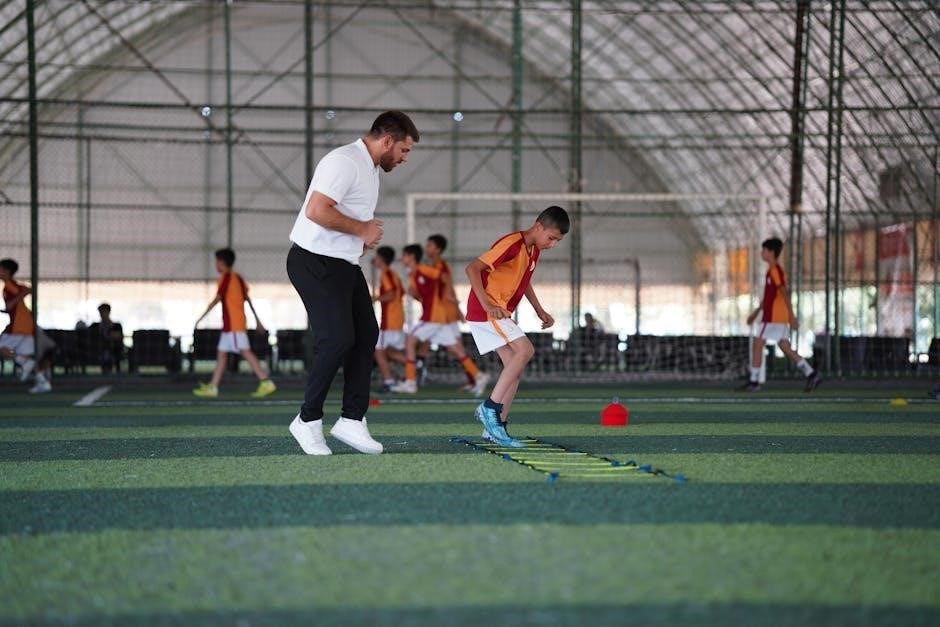
Safety Tips for Youth Football Drills
Ensure proper use of helmets and pads to prevent injuries. Teach safe tackling techniques and emphasize hydration to avoid dehydration. Supervise drills to maintain a secure environment.
9.1 Proper Hydration and Nutrition
Proper hydration and nutrition are vital for young athletes to perform optimally during football drills. Encourage players to drink water before, during, and after practices to prevent dehydration. Sports drinks can be beneficial for prolonged sessions. A balanced diet rich in carbohydrates, proteins, and healthy fats fuels energy levels and supports muscle recovery. Emphasize the importance of pre-game meals that are easy to digest, avoiding heavy or fatty foods. Teach athletes to listen to their bodies and refuel within 30 minutes post-session. Poor hydration and nutrition can lead to fatigue, decreased performance, and increased injury risk, making them essential components of youth football training.
9.2 Injury Prevention Strategies
Injury prevention is crucial in youth football to ensure player safety and longevity. Proper warm-up routines, including dynamic stretches and light cardio, help prepare muscles and reduce injury risk. Teach correct tackling and blocking techniques to minimize contact-related injuries. Emphasize the importance of using properly fitted equipment, such as helmets and pads. Encourage players to listen to their bodies and report any pain or discomfort. Incorporate cooldown stretches post-session to aid recovery. Supervise drills closely to ensure adherence to safety guidelines. Promote a culture of safety, where players prioritize technique over intensity. Regularly review and update safety protocols to align with best practices in youth sports.
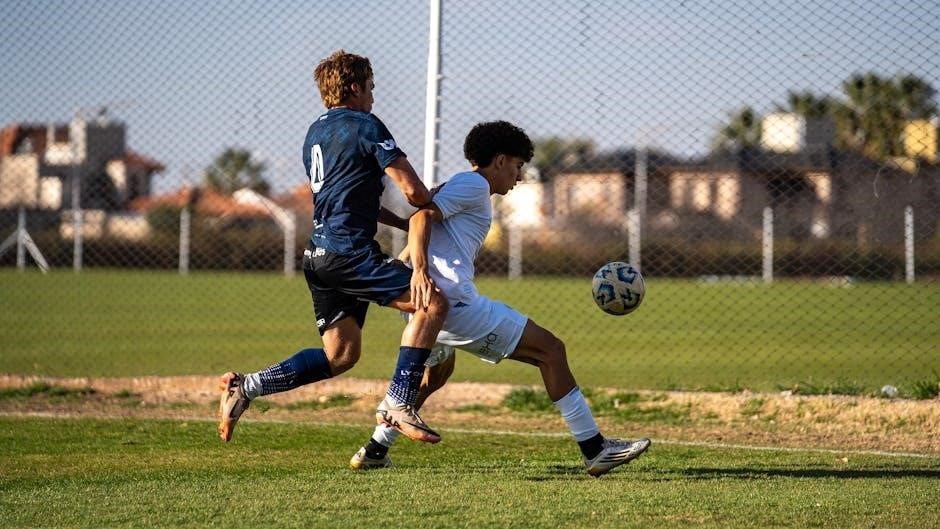
Resources for Coaches
Coaches can access free PDF guides and mobile apps for planning effective youth football drills, ensuring skill development and engagement for players of all ages.
10.1 Free PDF Guides for Youth Football Drills
Free PDF guides offer comprehensive resources for youth football coaches, providing detailed drills, skill development strategies, and safety tips. These guides are designed to cater to players of all skill levels, from beginners to advanced. They often include age-specific drills, ensuring exercises are appropriate for different developmental stages. Topics range from foundational skills like ball control and passing to advanced techniques such as tackling and blocking. Many guides also incorporate fun and engaging activities to keep young players motivated. Coaches can download these PDFs to plan structured training sessions, track progress, and foster teamwork. They are invaluable tools for creating a well-rounded football program.
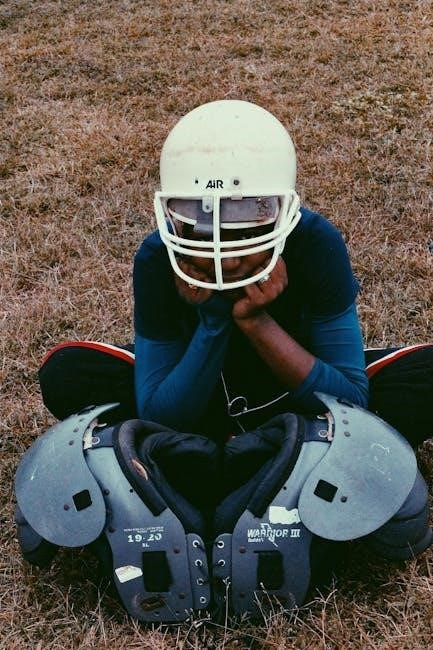
10.2 Recommended Mobile Apps for Drill Planning
Mobile apps have revolutionized how coaches plan and execute youth football drills. Apps like TeamSnap and Hudl offer tools for creating custom practice plans, analyzing player performance, and sharing drills with the team. They provide video tutorials, real-time feedback, and the ability to track progress. These apps are particularly useful for organizing age-specific drills, ensuring exercises are tailored to the skill level of young players. By leveraging technology, coaches can enhance engagement, improve skill development, and streamline communication with players and parents. These apps are indispensable for modern coaches aiming to create dynamic and effective training sessions.